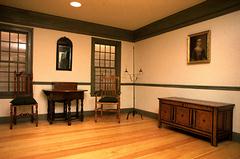Curriculum Materials: Art in America
|
|
Image 2a Foxon, Connecticut Questions: |
The Furnishings
Because all the furniture was lined up against the wall when not in use, to allow easier movement through the house, the Connecticut Room appears very formal. Most of the room's furnishings are simple and functional but contain decorative details of European style from the late 17th and early 18th centuries. Incorporating even the smallest details of familiar styles was one way for colonists to maintain ties, however loose, to their homelands.
Furniture decoration in the Connecticut Room consisted
mainly of two types: spindles turned on a lathe, for
example, the chair and table legs; and surface carving, as
on the Connecticut storage chest.
The chairs were painted to hide the fact that different
woods were used to construct them. Pillows make these
otherwise rigid forms more comfortable. The small table is
called a gateleg table because one leg swings out on each
side to support hinged leaves that make the surface larger.
On the table is a simply decorated box that once held a
family's most treasured possessions. The painted frame of
the mirror above the table imitates
LACQUER-ware imported to
Europe from the Far East. One of the few decorative items in
the home, the painting of a young girl
by Joseph Badger, exemplifies a popular type of
PORTRAIT from this
period.
|
|
